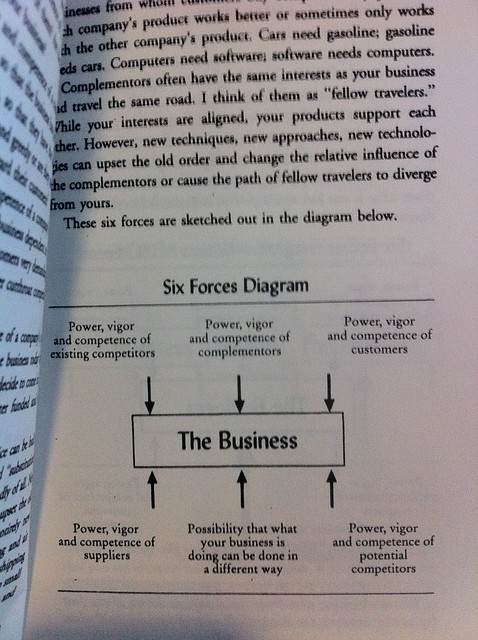I've recently started reading
Only The Paranoid Survive by Andrew Grove. It's fascinating in many ways.

"Sooner or later, something fundamental in your business world will change." p1

p29
"Then there is a growing dissonance between what your company thinks it is doing and what is actually happening inside the bowels of the organization. Such misalignment between corporate statements and operational actions hints at more than the normal chaos you have learned to live with." p34
"There will be a growing ferocity, determination and seriousness surrounding the views the various participants hold. People will dig in. These divergent views will be held equally strongly, almost like religious tenets. In a workplace that used to function collegially and constructively, holy wars will erupt, pitting coworkers against coworkers, long-term friends against long-term friends." p35
"when a strategic inflection point sweeps through the industry, the more successful a participant was in the old industry structure, the more threatened it is by change and the more reluctant it is to adapt to it." p50
"The first mover and only the first mover, the company that acts while the others dither, has a true opportunity to gain time over its competitors--and time advantage, in this business, is the surest way to gain market share.
Conversely, people who try to fight the wave of a new technology lose in spite of their best efforts because they waste valuable time." p51-52
"While Jobs was burning the midnight oil inside Next, in the outside world something changed." p58
"It was as if Steve Jobs and his company had gone into a time capsule when they started Next. They worked hard for years, competing against what they thought was the competition, but by the time they emerged, the competition turned out to be something completely different and much more powerful." p59
"the person who is the star of a previous era is often the last one to adapt to change, the last one to yield to the logic of a strategic inflection point and tends to fall harder than most." p68
"Most strategic inflection points, instead of coming in with a band, approach on little cat feet. They often are not clear until you can look at the events in retrospect." p107
"if you had just one bullet in a figurative pistol, whom among your many competitors would you save it for? Asked point-blank, this question usually provokes a visceral response and I find that people can normally give an answer without much hesitation. when the answer to this question stops being as crystal clear as it used to be and some of your people direct the silver bullet to competitors who didn't merit this kind of attention previously, it's time to sit up and pay attention." p107
"The Cassandras in your organization are a consistently helpful element in recognizing strategic inflection points. As you might remember, Cassandra was the priestess who foretold the fall of Troy. Likewise there are people who are quick to recognize impending change and cry out an early warning." p108
"Classify the time you spend listening to them as an investment in learning what goes on at the distant periphery of your business, whether you think of distances in geographical or technological terms. Think of it this way: when sprint comes, snow melts at the periphery, because that's where it's most exposed." p110
"It got there by the autonomous actions of the finance and production planning people, who sat around painstakingly allocating wafer production capacity month by month, moving silicon wafers from products where they seemed wasteful--memories were the prime example of this--to other products which seemed to generate better margins, such as microprocessors. These people didn't have the authority to get us out of memories but they had the authority to fine-tune the production allocation process by lots of little steps." p110
"Peter Drucker quotes a definition of an entrepreneur as someone who moves resources from areas of lower productivity and yield to areas of higher productivity and yield." p110
"you can't judge the significance of strategic inflection points by the quality of the first version" p113
"you must discipline yourself to think things through and separate the quality of the early versions from the longer-term potential and significance of a new product or technology." p114
"It takes courage to enter into a debate you may lose, in which weaknesses in your knowledge may be exposed and in which you may draw the disapproval of your coworkers for taking an unpopular viewpoint." p115
"Don't sit on the sidelines waiting for the senior people to make a decision so that later on you can criticize them over a beer" p115
"The point is, strategic inflections are rarely clear. Well-informed and well-intentioned people will look at the same picture and assign dramatically different interpretations to it. So it is extraordinarily important to bring the intellectual power of all relevant parties to this sharpening process." p116
"Altogether too often, people substitute opinions for facts and emotions for analysis." p116
"But data are about the past, and strategic inflection points are about the future. By the time the data showed that the Japanese memory producers were becoming a major factor, we were in the middle of a fight for our survival." p117
"Constructively debating tough issues and getting somewhere is only possible when people can speak their minds without fear of punishment." p117
"The most important role of managers is to create an environment in which people are passionately dedicated to winning in the marketplace. Fear plays a major role in creating and maintaining such passion. Fear of competition, fear of bankruptcy, fear of being wrong and fear of losing can all be powerful motivators." p117
"Simply put, fear can be the opposite of complacency. Complacency often afflicts precisely those who have been the most successful. It is often found in companies that have honed the sort of skills that are perfect for their environment. But when their environment changes these companies may be the slowest to respond properly." p118
"It takes many years of consistent conduct to eliminate fear of punishment as an inhibitor of strategic discussion. It takes only one incident to introduce it. News of this incident will spread through the organisation like wildfire and shut everyone up.
Once an environment of fear takes over, it will lead to paralysis throughout the organization and cut of the flow of bad news from the periphery." p119
"From our inception on, we at Intel have worked very hard to break down the walls between those who possess knowledge power and those who possess organization power." p120
"A manager in a business that's undergoing a strategic inflection point is likely to experience a variation of the well-known stages of what individuals go through when dealing with a serious loss." p124
"Denial is prevalent in the early stages of almost every example of a strategic inflection point I can think of." p124
"Good leaders are also subject to the same emotional wiggling. They, however, eventually emerge to the acceptance and action phases. Lesser leaders are not capable of that and they are often removed. Then they are replaced by individuals who are not necessarily more capable but who do not have the emotional investment in the previous strategy." p127
"The replacement of corporate heads is far more motivated by the need to bring in someone who is not invested in the past than to get somebody who is a better manager or a better leader in other ways." p127
"As we begin to respond, maybe too little too late, we face another emotional hurdle: to admit to ourselves consciously and explicitly the magnitude of the problem we are struggling with Even as our actions begin to reflect the process of adjusting to the new environment, we still struggle with the task of describing them in clear words." p128
"I have seen many companies fall into the trap of saying one thing and doing another while they are in the midst of coping with a strategic inflection. I call this divergence between actions and statements strategic dissonance. It is one of the surest indications that a company is struggling with a strategic inflection point." p128
"Occasionally when I stand in front of such a group and field questions, I find it awkward to attempt to defend the position of corporation in the face of some specific questions and comments that come from people who are wise to their world and their environment. Often these questions come in the form of follow-up questions after I have been asked about our specific strategy regarding a particular product, customer or technology." p129
"Such questions usually represent sharp probing for the true intent behind the general answer I've just given." p129
"Strategic dissonance is so much an automatic reaction to a strategic inflection point that probing for it is perhaps the best test of one." p129
"While this dissonance between what the company does and what management says is understandable, it accompanies a terribly unproductive and distressing phase. The growing discomfort associated with strategic dissonance creates confusion and uncertainty" p129
"To make it through the valley of death successfully, your first task is to form a mental image of what the company should look like when you get to the other side. This image not only needs to be clear enough for you to visualise but it also has to be crisp enough so you can communicate it simply to your tired, demoralised and confused staff." p140
"You are trying to define what the company will be, yet that can only be done if you also undertake to define what the company will
not be." p140
"the transformation implicit in surviving a strategic inflection point involves changing members of management in one way or another" p143
"The implication was that either the people in the room needed to change their areas of knowledge and expertise or the people themselves needed to be changed. I remember looking around the room, wondering who might remain and who might not." p143
"Admitting that you need to learn something new is always difficult. It is even harder if you are a senior manager who is accustomed to the automatic deference which people accord you owing to your position. But if you don't fight it, that very deference may become a wall that isolates you from learning new things." p145
"While strategic
plans are abstract and are usually couched in language that has no concrete meaning except to the company's management, strategic
actions matter because they immediately affect people's lives. They change people's work" p147
"Simply put, in times of change, managers almost always know which direction they should go in, but usually act too late and do too little." p149
"When you drive in the fog, it is a lot easier to drive fast if you're chasing the taillights of the car ahead of you. The danger with a 'taillight' strategy is that, once you catch up and pass, you will find yourself without a set of taillights to follow--and without the confidence and competence in setting your own course in a new direction." p149
"In recent years, we at Intel decided that we have a tremendous opportunity to exploit the personal computer as a universal information appliance." p 150
"it is very hard to lead an organization out of the valley of death without a clear and simple strategic direction. After all, getting there sapped the energy of your organization; it demoralised your employees and often set them against one another. Demoralized organizations are unlikely to be able to deal with multiple objectives in their actions. It will be hard enough to deal lead them out with a single one." p151
"If you're wrong, you will die. But most companies don't die because they are wrong; most die because they don't commit themselves. They fritter away their momentum and their valuable resources while attempting to make a decision. The greatest danger is in standing still." p152
"Clarity of direction, which includes describing what we are going after as well as describing what we will
not be going after, is exceedingly important at the late stage of a strategic transformation." p 153
"When you have to reach large numbers of people, you can't possibly overcommunicate and overclarify" p155
"Your new thoughts and new arguments will take awhile to sink in. But you will find that repetition sharpens your articulation of the new direction and makes it increasingly clear to your employees. So speak and answer questions as often as possible; while it may seem like like you're repeating yourself, in reality you will be reinforcing a strategic message." p155
"If your employees don't have an opportunity to test your thinking in live sessions or electronically, your message will seem like so much hot air.
Resist the temptation to do what's easy here. Communicating strategic change in an interactive, exposed fashion is not easy. But it is absolutely necessary." p157
"Simply put, you can't change a company without changing its management. I'm not saying they have to pack up their desks and be replaced. I'm saying that they themselves, every one of them, needs to change to be more in tune with the mandates of the new environment." p 157
"They need to adapt. If they can't or won't, however they will need to be replaced with others who are more in tune with the new world the company is heading to." p157
"It seems that companies that successfully navigate through strategic inflection points have a good dialectic between bottom-up and top-down actions." p159
"The Internet fosters the emergence of a third class of use: applications and data that are stored at some other computer someplace, prepared and owned by unrelated individuals or organisations, that anyone can access through this pervasive set of connections" p179
"All this suggests that the Internet is not a strategic inflection point for Intel. But while the classic signs suggest it isn't, the totality of all the changes is so overwhelming that deep down I think it i
s" p181
"Packaging Internet activities separately and elevating them on a par with our other three objectives is a way to communicate their significance to the entire company." p183
"It is likely that the Internet appliance is a case of turning the clock backward, given that the trend over the last twenty to thirty years has consisted of pulling down intelligence from big computers to little ones. I don't believe the Internet is about to reverse this trend. But then again, my genes were formed by those same twenty or thirty years. And I'm likely to be the last one to know." p184
Add comments on Buzz







